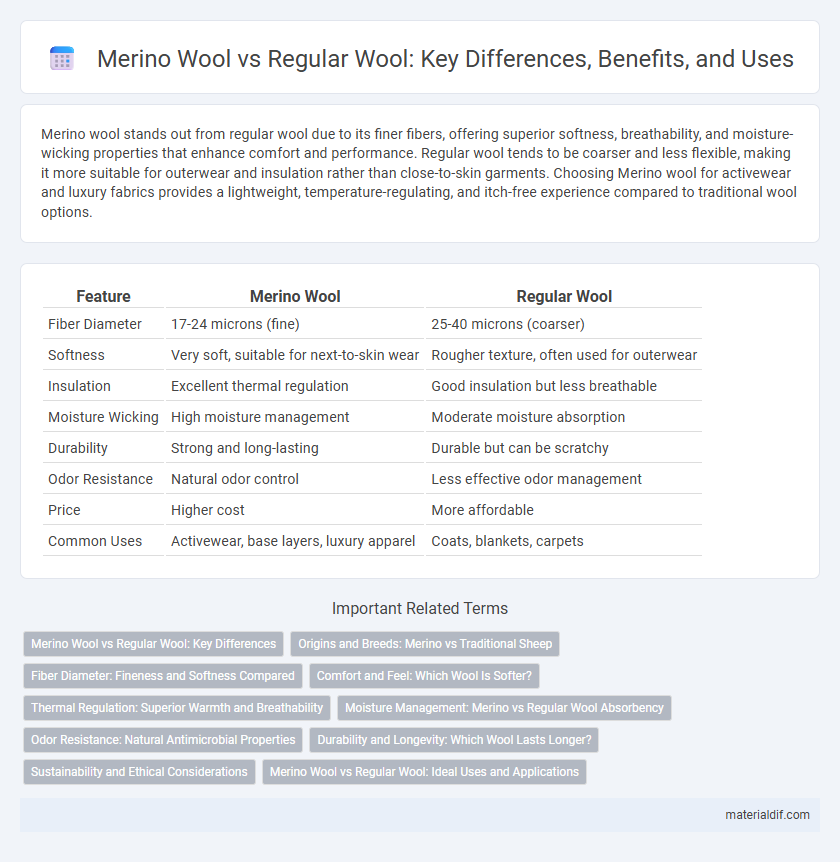Merino wool stands out from regular wool due to its finer fibers, offering superior softness, breathability, and moisture-wicking properties that enhance comfort and performance. Regular wool tends to be coarser and less flexible, making it more suitable for outerwear and insulation rather than close-to-skin garments. Choosing Merino wool for activewear and luxury fabrics provides a lightweight, temperature-regulating, and itch-free experience compared to traditional wool options.
Table of Comparison
| Feature | Merino Wool | Regular Wool |
|---|---|---|
| Fiber Diameter | 17-24 microns (fine) | 25-40 microns (coarser) |
| Softness | Very soft, suitable for next-to-skin wear | Rougher texture, often used for outerwear |
| Insulation | Excellent thermal regulation | Good insulation but less breathable |
| Moisture Wicking | High moisture management | Moderate moisture absorption |
| Durability | Strong and long-lasting | Durable but can be scratchy |
| Odor Resistance | Natural odor control | Less effective odor management |
| Price | Higher cost | More affordable |
| Common Uses | Activewear, base layers, luxury apparel | Coats, blankets, carpets |
Merino Wool vs Regular Wool: Key Differences
Merino wool is finer, softer, and more breathable than regular wool, making it ideal for sensitive skin and activewear. It offers superior moisture-wicking and temperature regulation, whereas regular wool is typically coarser and less flexible. Merino fibers also provide enhanced elasticity and durability, contributing to better comfort and longevity in garments.
Origins and Breeds: Merino vs Traditional Sheep
Merino wool originates from the Merino sheep breed, primarily raised in Australia and Spain, known for its fine, soft fibers that enhance comfort and thermal regulation. Regular wool comes from traditional sheep breeds such as Romney, Suffolk, and Cheviot, which produce coarser fibers better suited for durability and insulation. The distinct genetic traits of Merino sheep result in superior fiber fineness compared to traditional sheep, influencing the texture, breathability, and overall quality of the wool.
Fiber Diameter: Fineness and Softness Compared
Merino wool features an exceptionally fine fiber diameter, typically ranging from 15 to 24 microns, which results in superior softness and comfort compared to regular wool, whose fibers generally measure 25 microns and above. The finer fibers of Merino wool reduce itchiness and enhance breathability, making it ideal for sensitive skin and performance wear. Regular wool's coarser fibers often produce a rougher texture, suitable for durable outerwear but less comfortable for direct contact with the skin.
Comfort and Feel: Which Wool Is Softer?
Merino wool is renowned for its exceptional softness and fine fibers, measuring between 17 to 24 microns, which makes it significantly softer and more comfortable against the skin compared to regular wool, whose fibers often exceed 30 microns and can feel coarse. The finer micron count in Merino wool reduces itchiness and irritation, providing a smooth, luxurious feel ideal for sensitive skin. Regular wool, though durable and warm, tends to have a rougher texture that may cause discomfort during prolonged wear.
Thermal Regulation: Superior Warmth and Breathability
Merino wool outperforms regular wool in thermal regulation due to its finer fibers, which trap heat efficiently while allowing moisture to escape, ensuring superior warmth without overheating. The breathable structure of Merino wool adapts to body temperature, providing optimal comfort in both cold and warm conditions. Regular wool tends to be coarser, offering insulation but lacking the enhanced breathability and softness that make Merino ideal for active wear and varying climates.
Moisture Management: Merino vs Regular Wool Absorbency
Merino wool outperforms regular wool in moisture management due to its finer fibers, which enhance breathability and moisture-wicking properties. It can absorb up to 30% of its weight in moisture without feeling damp, whereas regular wool tends to retain more moisture and dries slower. This superior absorbency makes Merino wool ideal for activewear and outdoor gear, ensuring comfort and dryness in varying conditions.
Odor Resistance: Natural Antimicrobial Properties
Merino wool offers superior odor resistance compared to regular wool due to its natural antimicrobial properties that inhibit the growth of odor-causing bacteria. The fine fibers of Merino wool create a breathable fabric that efficiently wicks moisture away from the skin, reducing conditions favorable to bacterial proliferation. This makes Merino wool an ideal choice for activewear and outdoor clothing where prolonged freshness is essential.
Durability and Longevity: Which Wool Lasts Longer?
Merino wool outperforms regular wool in durability and longevity due to its finer, stronger fibers that resist pilling and wear over time. Regular wool, while sturdy, tends to be coarser and more prone to abrasion, resulting in shorter garment lifespan. Investing in Merino wool ensures longer-lasting apparel with maintained softness and resilience through repeated use and washing.
Sustainability and Ethical Considerations
Merino wool is often considered more sustainable and ethical compared to regular wool due to its finer fibers requiring less processing and its sheep being bred in more environmentally managed systems. Unlike conventional wool production, Merino wool farms commonly emphasize animal welfare practices such as mulesing avoidance and rotational grazing to enhance soil health and biodiversity. The eco-friendly attributes of Merino wool reduce water consumption and chemical use, making it a preferable choice for environmentally conscious consumers.
Merino Wool vs Regular Wool: Ideal Uses and Applications
Merino wool, prized for its exceptional softness and fine fibers, is ideal for high-performance athletic wear, base layers, and luxury garments that require moisture-wicking and temperature regulation. Regular wool, with its coarser texture and greater durability, is better suited for outerwear, heavy-duty blankets, and insulation applications where toughness and warmth retention are crucial. The superior breathability and odor resistance of Merino wool make it the preferred choice for close-to-skin use, whereas regular wool excels in rugged, outdoor apparel and home textiles.
Merino Wool vs Regular Wool Infographic

 materialdif.com
materialdif.com